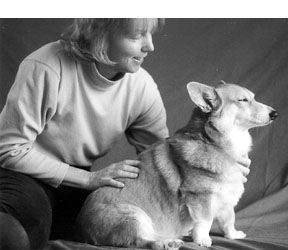Dogs that compete in field trials, agility or herding competitions or those that play fly-ball or Frisbee automatically come to mind as canine athletes. Then there are seeing-eye dogs, rescue dogs, police dogs, drug dogs, and a host of others whose work is just as athletically challenging.
It is easy to understand how these top performance animals might benefit from massage. The fact is, however, that even our four-legged friends who aspire to perfect their skills as couch potatoes are athletes in their own right. This is true even if their most energetic pursuits are chasing a squirrel or a brief romp in the yard. All of our canine friends, including those with demanding jobs, those who prefer a more leisurely life style, and those with chronic problems that hinder activity, can benefit from massage.
What is canine massage?

Massage is a hands-on manipulation of the muscles and other soft tissues with the intent of benefiting the animal. In other words, massage is touch with a purpose and it yields many physical and emotional benefits.
Physically, massage stimulates circulation, enhances range of motion, relieves muscle spasms, and encourages a healthier coat. The positive effects on mental attitude and emotions are just as important. For example, massage promotes relaxation, reduces stress, fosters a sense of well-being, and strengthens the bond between human and animal.
Massage, which to the casual observer appears to range from gentle stroking to more vigorous kneading and percussion of tissues, affects the dog physically and emotionally by markedly influencing the nerve, muscle, circulatory and lymph systems of the body. As a matter of fact, none of the body’s systems works in isolation.
It is estimated that the human body has 60,000 miles of capillaries. Dogs have a proportionately similar amount, taking into consideration the size difference between a Chihuahua and Great Dane. Each muscle fiber or cell is surrounded by three or four of these tiny blood vessels, which bring oxygen and nutrients to the cells and carry waste products away. The nervous system communicates with each muscle cell through processes of the several million neurons (or nerve cells) which carry messages to the brain indicating whether the muscle is relaxed, contracted, or injured. Similarly, messages return to the muscles and stimulate them to respond to stimuli by contracting or relaxing.
With this abundance of nerve and muscle cells and their associated capillaries, it is not difficult to understand the impact that touch has on the body.
The number of cells influenced by a single gentle stroke along the length of the body is mind-boggling. Massage enhances circulation by stimulating the movement of blood through the capillaries. This increases the supply of oxygen and nutrients to muscle cells and carries away waste products and toxins generated by contraction. Stimulation by massage of muscle and nerve cells enhances muscle tone. Tiny areas of muscle in spasm are encouraged to relax and the overall health of muscle and nerve are improved.
Also, massage relaxes your dog just as a massage or even a good shoulder and back rub relaxes your tight muscles when you are stressed. Massage also affects the capillaries that nourish the skin with oxygen and nutrients and cleanse it of wastes and toxins. This fosters a healthy skin and coat.
The mind/muscle connection
Your dog’s body works just like yours. Daily use or lack of it can cause muscles to become tight, sore, stiff, or flaccid. Emotional stress can also affect your dog’s muscles and general well-being. How does your dog react to potentially stressful situations like a trip to the vet, separation from you, or an encounter with a neighborhood dog? Like humans, part of a dog’s response to stress may manifest as tense, tight muscles. Massage can go a long way to reverse the adverse results of stress-producing events by relaxing your dog, relieving his tension. It can also greatly enhance your bond with your dog.
We must keep in mind that the systems of the body work together as an integrated unit. Events – good or bad – that impact one system lead to a cascade of effects that eventually impact all systems.
A “whole body” dynamic
Consider, for example, what happens if your dog suffers a cut on one of his paws. Certainly there will be some loss of blood and infection-fighting white blood cells will rush to the area. The involvement of the circulatory system is obvious. Then the area surrounding the cut will swell with cellular fluids released due to the damage. Now the lymphatic system will swing into action to decrease the swelling by removing the excess fluid and carrying off other cellular debris resulting from the injury.
Because the dog’s paw is sore, he may compensate for the pain by limping or shifting weight from one part of the body to another. This can stress healthy joints and muscles causing them to become misaligned and strained and to suffer abnormal wear and tear.
Needless to say, the pain will affect the dog, emotionally lowering his spirits and possibly his appetite.
Just as a minor cut can upset the body’s balance and affect some aspect of virtually every system, massage can bring about positive changes to many systems of the body. An open wound should never be directly massaged. However, massage above or below an injury can stimulate blood flow which increases the supply of nutrients needed for repair and healing. Similarly, a stimulated lymph system hastens removal of wastes and excess fluids so swelling recedes.
A complement
Massage is not a substitute for conventional veterinary care but can often be very effectively used in conjunction with it to provide maximum benefit to your dog. There are times when massage is contraindicated. As noted, one should never massage an open wound. Similarly, massage is contraindicated over surgical sites, insect bites, and skin infections. Massage is also inappropriate for an animal that has a temperature or swollen lymph glands, or cancer, is in a state of shock, or has a broken bone or ruptured disk. These conditions require conventional veterinary care.
Massage can benefit the rapidly growing muscles and mind of a puppy, the hard-working body of a canine athlete, and the chronic problems like hip dysplasia and arthritis common in older dogs. In future articles, we will specifically address some of these issues.
-By Sue Furman
Sue Furman teaches canine and equine massage classes and is active as a free-lance writer. She also conducts research on nerve and muscle as a faculty member in the Department of Anatomy and Neurobiology at Colorado State University in Ft. Collins, CO.







急な融資が希望の時には、財務状況の良い融資会社を利用することが大切です。実際に活用してみると、有利な資金調達を受けることができます。業者を選択する時は、慎重に借り入れをすることが重要です。